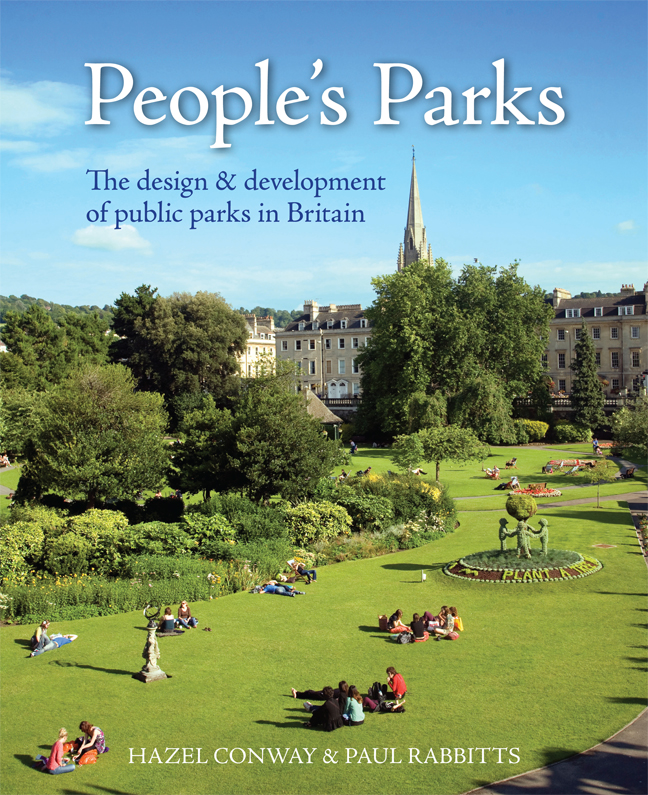Book contents
- Frontmatter
- Dedication
- Contents
- Miscellaneous Frontmatter
- Preface
- Acknowledgements
- Foreword
- A Word from Parks Professionals, Politicians and Parks Organisations
- Introduction: Dr Hazel Conway (1991)
- 1 Public Parks and Municipal Parks
- 2 The Need for Parks
- 3 Pioneering Parks Development
- 4 The Park Movement
- 5 Design and Designers
- 6 Lodges, Bandstands and the Cultivation of Virtue
- 7 Local Pride and Patriotism
- 8 Planting and Park Maintenance
- 9 Permitted Pastimes
- 10 Recreation Grounds, Parks and the Urban Environment
- 11 Public Parks, 1885–1914
- 12 Later Municipal Park Designers
- 13 Garden Cities and the New Towns Movement
- 14 Sport, Physical Activity and Recreation in Public Parks in the Inter-war Years
- 15 Parks Management – a Changing Perspective
- 16 Decline, Revival and Renewal – the Role of Parks into 21st-century Britain
- Appendix 1 Summary of main legislation promoting early park development
- Appendix 2 Chronology of main municipal and public park developments between 1800 and 1885
- Notes
- Bibliography
- Subscription List
- Index
8 - Planting and Park Maintenance
Published online by Cambridge University Press: 22 February 2024
- Frontmatter
- Dedication
- Contents
- Miscellaneous Frontmatter
- Preface
- Acknowledgements
- Foreword
- A Word from Parks Professionals, Politicians and Parks Organisations
- Introduction: Dr Hazel Conway (1991)
- 1 Public Parks and Municipal Parks
- 2 The Need for Parks
- 3 Pioneering Parks Development
- 4 The Park Movement
- 5 Design and Designers
- 6 Lodges, Bandstands and the Cultivation of Virtue
- 7 Local Pride and Patriotism
- 8 Planting and Park Maintenance
- 9 Permitted Pastimes
- 10 Recreation Grounds, Parks and the Urban Environment
- 11 Public Parks, 1885–1914
- 12 Later Municipal Park Designers
- 13 Garden Cities and the New Towns Movement
- 14 Sport, Physical Activity and Recreation in Public Parks in the Inter-war Years
- 15 Parks Management – a Changing Perspective
- 16 Decline, Revival and Renewal – the Role of Parks into 21st-century Britain
- Appendix 1 Summary of main legislation promoting early park development
- Appendix 2 Chronology of main municipal and public park developments between 1800 and 1885
- Notes
- Bibliography
- Subscription List
- Index
Summary
For many park visitors it was the flowers that were the main attraction, and park superintendents at the beginning of the 20th century strove to satisfy this taste by providing ‘vast expanses of colour over as long a period as possible’. Spring bulbs were followed by hardy and half-hardy annuals and other summer flowering plants and these were replaced, as summer drew to a close, by dahlias and chrysanthemums. These floral displays cheered the visitors, as well as holding a deeper significance by providing metaphors about society as a whole. During the course of the park movement, the emphasis on flowers varied, as did styles of planting and the types of gardens in which flowers were planted. Since so many municipal parks were located in areas of heavy air pollution, this proved a significant influence on the type of planting that was possible.
One of the main differences between the gardening of the 18th and the 19th centuries had been the prolific growth in the new species available, for many new plants and trees had been brought back to Britain from Australasia, North and South America and Asia. Some of them became acclimatised, while others needed protection from the rigours of the British climate if they were to thrive at all. Gardeners faced the problem of growing an increasing variety of unfamiliar plants and sought ways of incorporating them into an overall theory of landscape design. Repton's principles of landscape gardening advocated variety and contrast, with particular species planted in different types of gardens, such as the rock garden, the flower garden, the American garden, rosarium and arboretum. Within these gardens individual plants or species did not tend to be emphasised. The great increase in new and exotic species encouraged the wish to show individual plants and trees to advantage, and it was J C Loudon's development of the gardenesque school of landscape gardening which provided the principles for such planting. The aim of the gardenesque school was to allow individual plants to develop to their full glory and ‘to add, to the acknowledged charms of the Repton school, all those [of] which the sciences of gardening and botany in their present advanced state are capable’.
At Derby Arboretum trees and shrubs were planted so that their growth was uninhibited.
- Type
- Chapter
- Information
- People's ParksThe design & development of public parks in Britain, pp. 135 - 150Publisher: Boydell & BrewerPrint publication year: 2023



